Railway Technology: How Ladder Track Systems Are Changing the Game
Ever noticed how trains keep running smoothly even on tough terrains? A big part of that is down to the railway tracks and the technology behind them. Among the recent shifts in railway tech, ladder tracks stand out for the way they support rails differently than traditional tracks. Instead of just sleepers under rails, ladder tracks use long beams with cross connectors, making the setup sturdier and easier to maintain.
What makes ladder track systems so appealing? For starters, they handle vibrations better and reduce noise, which is a major plus in urban areas. Some smart tweaks like Tubular Modular Track add strength while cutting down wear-and-tear, making rail travel safer and more reliable. Plus, they’re great in tricky conditions — think wet or desert regions — where regular tracks might struggle.
Why Are Ladder Tracks Making a Comeback?
This isn’t some brand-new idea. Ladder tracks date back to the British railways of the 1800s but faded away for a while. Now, with modern materials and design tweaks, they’re gaining favor again. Rail projects like South Africa’s Gautrain use these systems due to their lower impact on the ground and ease of installation.
Another win? Ladder tracks often mean less maintenance hassle and longer service life. Maintenance crews can work quicker because the modular parts let them swap or adjust sections without tearing the entire track apart. For busy rail lines, this can mean fewer delays and safer rides.
What Does This Mean for Rail Travel?
With rising demands on public transport, having robust and low-maintenance rail systems is key. Ladder track technology answers this need by combining old-school design wisdom with fresh engineering tricks. It opens doors to smoother rides, less downtime, and better adaptability to different environments.
So, next time you’re on a train gliding over a bridge or through the city, remember there’s smart tech beneath your feet, making that journey possible and comfortable. Railway tech like ladder tracks keeps evolving, helping railways keep pace with today's travel and transport needs.
Ladder track is a railway track design that uses longitudinal supports connected by transverse beams to keep the rails correctly spaced. Originating in early British railways, it was largely replaced by sleeper tracks by 1860 due to certain limitations. Today, ladder tracks are experiencing a revival thanks to modern advancements that increase stability, lower noise, and reduce maintenance, particularly in specialized areas like mining and urban transit systems.
Ladder Track systems, with their historical roots in 19th-century railways, are making a comeback due to their modern adaptations. These tracks promise reduced maintenance and enhanced stability with innovative designs like Tubular Modular Track and RTRI Japan's configurations. Ideal across diverse environments, ladder tracks cater to the evolving needs of contemporary rail infrastructure.
Latest Posts
Wimbledon Star Barbora Krejcikova Reveals Unusual Pre-Match Routine That Fueled Her Success
Jul 13 2024


 Sports
Sports